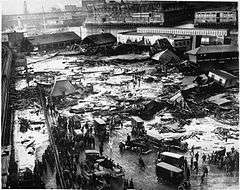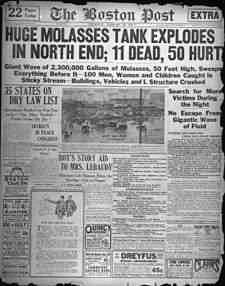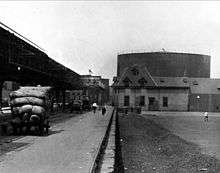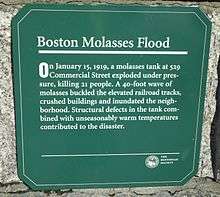Great Molasses Flood
 Aftermath of the disaster | |
| Date | January 15, 1919 |
|---|---|
| Location | Boston, Massachusetts |
| Coordinates | 42°22′06.6″N 71°03′21.0″W / 42.368500°N 71.055833°WCoordinates: 42°22′06.6″N 71°03′21.0″W / 42.368500°N 71.055833°W |
| Cause | Cylinder stress failure |
| Casualties | |
| 21 dead | |
| 150 injured | |
The Great Molasses Flood, also known as the Boston Molasses Disaster or the Great Boston Molasses Flood, occurred on January 15, 1919, in the North End neighborhood of Boston, Massachusetts, in the United States. A large molasses storage tank burst, and a wave of molasses rushed through the streets at an estimated 35 mph (56 km/h), killing 21 and injuring 150.
The event has entered local folklore, and for decades afterward, residents claimed that on hot summer days the area still smelled of molasses.[1]
Flood

The disaster occurred at the Purity Distilling Company facility on January 15, 1919. The temperature had risen above 40 °F (4 °C), climbing rapidly from the frigid temperatures of the preceding days.[2]:91, 95
Molasses can be fermented to produce rum and ethanol, the active ingredient in other alcoholic beverages and a key component in the manufacturing of munitions.[2]:11 The stored molasses was awaiting transfer to the Purity plant situated between Willow Street and what is now named Evereteze Way, in Cambridge.

At about 12:30 in the afternoon near Keany Square,[3] at 529 Commercial Street, a molasses tank 50 ft (15 m) tall, 90 ft (27 m) in diameter, and containing as much as 2,300,000 US gal (8,700 m3), collapsed. Witnesses variously reported that as it collapsed they felt the ground shake and heard a roar, a long rumble similar to the passing of an elevated train (coincidentally, with a line of that type close by), a tremendous crashing, a deep growling, or a thunderclap-like bang!, and as the rivets shot out of the tank, a machine gun-like sound.[2]:92–95
The collapse unleashed a wave of molasses 25 ft (8 m) high at its peak,[4] moving at 35 mph (56 km/h).[1] The molasses wave was of sufficient force to damage the girders of the adjacent Boston Elevated Railway's Atlantic Avenue structure and tip a railroad car momentarily off the tracks. Author Stephen Puleo describes how nearby buildings were swept off their foundations and crushed. Several blocks were flooded to a depth of 2 to 3 ft (60 to 90 cm). Puleo quotes a Boston Post report:
Molasses, waist deep, covered the street and swirled and bubbled about the wreckage ... Here and there struggled a form—whether it was animal or human being was impossible to tell. Only an upheaval, a thrashing about in the sticky mass, showed where any life was ... Horses died like so many flies on sticky fly-paper. The more they struggled, the deeper in the mess they were ensnared. Human beings—men and women—suffered likewise.[2]:98

The Boston Globe reported that people "were picked up by a rush of air and hurled many feet." Others had debris hurled at them from the rush of sweet-smelling air. A truck was picked up and hurled into Boston Harbor. About 150 people were injured; 21 people and several horses were killed, Some were crushed and drowned by the molasses. The wounded included people, horses, and dogs; coughing fits became one of the most common ailments after the initial blast. In a 1983 article for Smithsonian, Edwards Park wrote of one child's experience:
Anthony di Stasio, walking homeward with his sisters from the Michelangelo School, was picked up by the wave and carried, tumbling on its crest, almost as though he were surfing. Then he grounded and the molasses rolled him like a pebble as the wave diminished. He heard his mother call his name and couldn't answer, his throat was so clogged with the smothering goo. He passed out, then opened his eyes to find three of his four sisters staring at him.[1]
Aftermath

First to the scene were 116 cadets under the direction of Lieutenant Commander H. J. Copeland from USS Nantucket, a training ship of the Massachusetts Nautical School (which is now the Massachusetts Maritime Academy), that was docked nearby at the playground pier.[3] They ran several blocks toward the accident. They worked to keep the curious from getting in the way of the rescuers, while others entered into the knee-deep, sticky mess to pull out the survivors. Soon, the Boston Police, Red Cross, Army, and other Navy personnel arrived. Some nurses from the Red Cross dove into the molasses, while others tended to the injured, keeping them warm and keeping the exhausted workers fed. Many of these people worked through the night. The injured were so numerous that doctors and surgeons set up a makeshift hospital in a nearby building. Rescuers found it difficult to make their way through the syrup to help the victims. Four days elapsed before they stopped searching for victims; many of the dead were so glazed over in molasses, they were hard to recognize.[1]
Local residents brought a class-action lawsuit, one of the first held in Massachusetts, against the United States Industrial Alcohol Company (USIA), which had bought Purity Distilling in 1917. In spite of the company's attempts to claim that the tank had been blown up by anarchists[2]:165 (because some of the alcohol produced was to be used in making munitions), a court-appointed auditor found USIA responsible after three years of hearings. United States Industrial Alcohol Company ultimately paid out $600,000 in out-of-court settlements.[5] Survivors of the fatal victims reportedly received around $7,000 per victim.[1]
Cleanup
Cleanup crews used salt water from a fireboat to wash the molasses away, and used sand to try to absorb it.[6] The harbor was brown with molasses until summer. The cleanup in the immediate area took "weeks",[7] with more than 300 people contributing to the effort.[2]:132–134, 139 The cleanup in the rest of Greater Boston and its suburbs would take an indefinably longer time. Rescue workers, cleanup crews, and sight-seers had tracked molasses through the streets and spread it to subway platforms, to the seats inside trains and streetcars, to pay telephone handsets, into homes,[1][2]:139 and to countless other places. "Everything a Bostonian touched was sticky."[1]
Fatalities
| Name | Age | Occupation |
|---|---|---|
| Patrick Breen | 44 | Laborer (North End Paving Yard) |
| William Brogan | 61 | Teamster |
| Bridget Clougherty | 65 | Homemaker |
| Stephen Clougherty | 34 | Unemployed |
| John Callahan | 43 | Paver (North End Paving Yard) |
| Maria Di Stasio | 10 | Child |
| William Duffy | 58 | Laborer (North End Paving Yard) |
| Peter Francis | 64 | Blacksmith (North End Paving Yard) |
| Flaminio Gallerani | 37 | Driver |
| Pasquale Iantosca | 10 | Child |
| James H. Kenneally | Unknown | Laborer (North End Paving Yard) |
| Eric Laird | 17 | Teamster |
| George Layhe | 38 | Firefighter (Engine 31) |
| James Lennon | 64 | Teamster/Motorman |
| Ralph Martin | 21 | Driver |
| James McMullen | 46 | Foreman, Bay State Express |
| Cesar Nicolo | 32 | Expressman |
| Thomas Noonan | 43 | Longshoreman |
| Peter Shaughnessy | 18 | Teamster |
| John M. Seiberlich | 69 | Blacksmith (North End Paving Yard) |
| Michael Sinnott | 76 | Messenger |
Causes

Several factors that occurred on that day and the previous days might have contributed to the disaster. The tank was constructed poorly and tested insufficiently. Due to fermentation occurring within the tank, carbon dioxide production might have raised the internal pressure. The rise in local temperatures that occurred over the previous day also would have assisted in building this pressure. Records show that the air temperature rose from 2 to 41 °F (−17 to 5.0 °C) over that period. The failure occurred from a manhole cover near the base of the tank, and a fatigue crack there possibly grew to the point of criticality. The hoop stress is greatest near the base of a filled cylindrical tank.
The tank had been filled to capacity only eight times since it was built a few years previously, putting the walls under an intermittent, cyclical load. Several authors say that the Purity Distilling Company was (or may have been) trying to outrace prohibition in the United States;[8][9][10] the Eighteenth Amendment to the Constitution of the United States was ratified the next day (January 16, 1919), and took effect one year later.[11]
An inquiry after the disaster revealed that Arthur Jell, who oversaw the construction, neglected basic safety tests, such as filling the tank with water to check for leaks. When filled with molasses, the tank leaked so badly that it was painted brown to hide the leaks. Local residents collected leaked molasses for their homes.[5]
An investigation first published in 2014, applying modern engineering analysis, found that the steel was not only half as thick as it should have been for a tank of its size, even with the lax standards of the day, but it also lacked manganese, and was made more brittle as a result.[12]
In 2016, a team of scientists and students at Harvard University conducted extensive studies of the historic disaster, gathering data from many sources, including 1919 newspaper articles, old maps, and weather reports.[13] The student researchers also studied the behavior of cold corn syrup flooding a scale model of the affected neighborhood.[14] The researchers concluded that the reports of the high speed of the flood were credible.[14]
Two days before the disaster, warmer molasses had been added to the tank, reducing the viscosity of the fluid. When the tank collapsed the fluid cooled quickly as it spread, until it reached Boston's winter evening temperatures and the viscosity increased dramatically.[15] The Harvard study concluded that the molasses cooled and thickened quickly as it rushed through the streets, hampering efforts to free victims before they suffocated.[13][14] The study results were presented at a November 2016 meeting of the American Physical Society.[14][16]
The area today

United States Industrial Alcohol did not rebuild the tank. The property formerly occupied by the molasses tank and the North End Paving Company became a yard for the Boston Elevated Railway (predecessor to the Massachusetts Bay Transportation Authority). It currently is the site of a city-owned recreational complex, officially named Langone Park, featuring a Little League Baseball field, a playground, and bocce courts.[17] Immediately to the east is the larger Puopolo Park, with additional recreational facilities.[18]
A small plaque at the entrance to Puopolo Park, placed by the Bostonian Society, commemorates the disaster.[19] The plaque, titled "Boston Molasses Flood", reads:
On January 15, 1919, a molasses tank at 529 Commercial Street exploded under pressure, killing 21 people. A 40-foot wave of molasses buckled the elevated railroad tracks, crushed buildings and inundated the neighborhood. Structural defects in the tank combined with unseasonably warm temperatures contributed to the disaster.
Cultural influences
Many laws and regulations governing construction were changed as a direct result of the disaster, including requirements for oversight by a licensed architect, and materials and structural testing.
One of the DUKW amphibious tourist vehicles operated by Boston Duck Tours, appropriately painted dark brown, has been named Molly Molasses in remembrance of the event, per the firm's practice of naming their DUKWs after famous Boston locations, events, and other bits of local culture.[20]
The 2015 novel A Head Full of Ghosts by Paul Tremblay references the Great Molasses Flood in an early scene. Marjorie Barrett tells her younger sister the horrific story of Maria Di Stasio drowning in the molasses. When questioned about it, she claims that she awoke with Maria's memories.
See also
- Honolulu molasses spill (September 2013)
- London Beer Flood
References
- 1 2 3 4 5 6 7 Park, Edwards (November 1983). "Without Warning, Molasses in January Surged Over Boston". Smithsonian. 14 (8): 213–230. Retrieved March 24, 2013. Reprinted at Eric Postpischil's Domain, "Eric Postpischil's Molasses Disaster Pages, Smithsonian Article", June 14, 2009.
- 1 2 3 4 5 6 7 8 Puleo, Stephen (2004). Dark Tide: The Great Boston Molasses Flood of 1919. Beacon Press. ISBN 0-8070-5021-0.
- 1 2 3 "12 Killed When Tank of Molasses Explodes" (PDF). The New York Times (published January 16, 1919). January 15, 1919. ISSN 0362-4331. Retrieved May 30, 2008.
- ↑ Jabr, Ferris (July 17, 2013). "The Science of the Great Molasses Flood". Scientific American. Retrieved October 16, 2013.
- 1 2 Adams, Cecil (December 31, 2004). "Was Boston once literally flooded with molasses?". The Straight Dope. The Chicago Reader. Retrieved December 16, 2006.
- ↑ "The Great Boston Molasses Disaster of 1919". The Hour. United Press International. January 17, 1979.
- ↑ Mason, John (January 1965). "The Molasses Disaster of January 15, 1919". Yankee. Reprinted at Eric Postpischil's Domain, "Eric Postpischil's Molasses Disaster Pages, Yankee Magazine Article", June 14, 2009. Retrieved June 8, 2014.
- ↑ Puleo, Stephen (2010). Dark Tide: The Great Molasses Flood of 1919. Beacon Press. p. 79.
Any disruption at the tank could prove disastrous to his plan to outrun Prohibition by producing alcohol as rapidly as possible at the East Cambridge distillery.
- ↑ Stanley, Robert (1989). "Footnote to History". Yankee. 53: 101.
In January of 1919 Purity Distilling Company of Boston, maker of high-grade rum, was working three shifts a day in a vain attempt to outrun national Prohibition.
- ↑ Silverman, Steve (2001). Einstein's Refrigerator: And Other Stories from the Flip Side of History. Andrews McMeel. p. 37. ISBN 978-0-7407-1419-1.
First, it was believed that the tank was overfilled because of the impending threat of Prohibition.
- ↑ Streissguth, Thomas (2009). The Roaring Twenties. Infobase. p. 13. ISBN 978-1-4381-0887-2.
- ↑ Schworm, Peter (January 15, 2015). "Nearly a century later, new insight into cause of Great Molasses Flood of 1919". Boston Globe. Retrieved January 16, 2015.
- 1 2 "Slow as molasses? Sweet but deadly 1919 disaster explained". Boston.com. Associated Press. 24 November 2016. Retrieved 2016-12-03.
- 1 2 3 4 Mccann, Erin (26 November 2016). "Solving a Mystery Behind the Deadly 'Tsunami of Molasses' of 1919". The New York Times. Retrieved 2016-12-03.
- ↑ "Molasses Creates a Sticky Situation". AlphaGalileo. November 17, 2016. Retrieved November 25, 2016.
- ↑ Nicole Sharp, Jordan Kennedy, Shmuel Rubinstein (November 21, 2016). "Abstract: L27.00008 : In a sea of sticky molasses: The physics of the Boston Molasses Flood". Bulletin of the American Physical Society. American Physical Society. Retrieved November 25, 2016.
- ↑ Harris, Patricia; Lyon, David (2004). Boston: a Guide to Unique Places. The Globe Pequot Press. pp. 63–64. ISBN 0-7627-3011-0.
- ↑ "Places to go: Downtown/North End". The Boston Harbor Association. Archived from the original on September 13, 2013. Retrieved September 5, 2013.
- ↑ Ocker, J.W. (2010). The New England Grimpendium. Woodstock, VT: The Countryman Press. p. 97. ISBN 978-0-88150-919-9.
- ↑ "Old Army trucks find a home — and triage". Boston Globe, Billy Baker November 11, 2014
- Puleo, Stephen (2004). Dark Tide: The Great Boston Molasses Flood of 1919. Boston: Beacon Press. ISBN 0-8070-5021-0.
External links
| Wikimedia Commons has media related to Boston Molasses Disaster. |
- Boston Public Library. Photos related to the event on Flickr. Many phrases are direct quotes.
- The Great Boston Molasses Flood of 1919, four-minute audio story at The American Storyteller Radio Journal
- Interview with Stephen Puleo, author of the book listed in References section above
- Molasses flood site, present-day pictures and list of 1919 inhabitants, at archive.org
- Molasses Flood of 1919
- "Scenes in the Molasses-Flooded Streets of Boston", from the Washington Times, January 18, 1919